The Ultimate Guide to Smoking a Tender Brisket: Tips, Techniques, and Common Mistakes
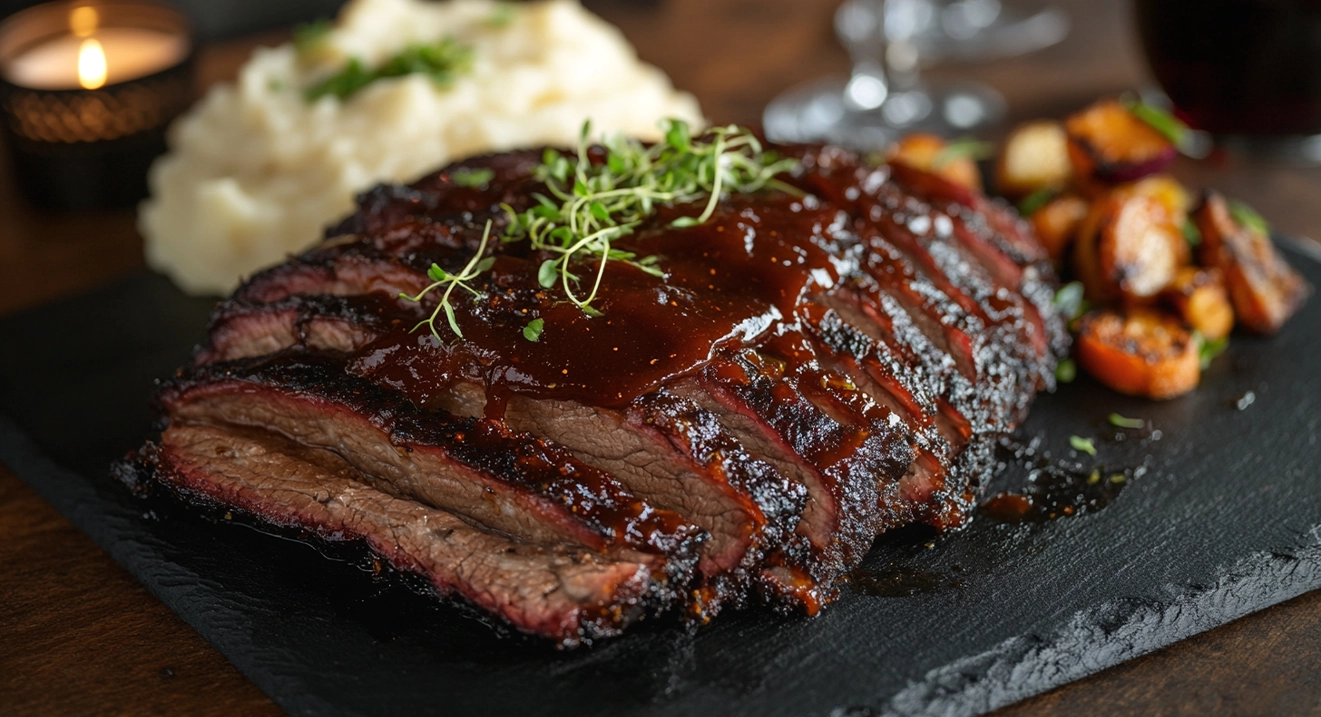
Introduction to Smoked Brisket
The Allure of Smoked Brisket
Smoked brisket is a beloved dish known for its deep, smoky flavor and tender, melt-in-your-mouth texture. Its allure comes from the slow-cooking process, which allows the meat to absorb the flavors of wood smoke while becoming irresistibly juicy and flavorful. The careful balance of seasoning, smoke, and patience turns a humble cut of meat into a showstopper at any barbecue or special meal.
Choosing the Right Brisket Cut
When selecting brisket, it’s essential to understand the differences between the two main cuts: the flat and the point. Each cut offers unique characteristics, making one more suitable than the other depending on your cooking method and desired outcome.
Different Brisket Cuts: Flat vs. Point
Flat Cut (First Cut):
The flat cut is the leaner portion of the brisket, often preferred for recipes that require slices of meat, such as sandwiches or BBQ. It has less fat, making it easier to trim and cook more evenly. However, it is leaner and can sometimes dry out if not cooked properly, so it’s often used in slow cooking methods like braising or smoking.
Point Cut (Second Cut):
The point cut is fattier, with more marbling throughout the meat, which gives it more flavor and tenderness when cooked. It’s ideal for slow-cooked dishes that benefit from the additional fat, such as smoked brisket, or for making burnt ends. The extra fat also helps to keep the meat moist and juicy.
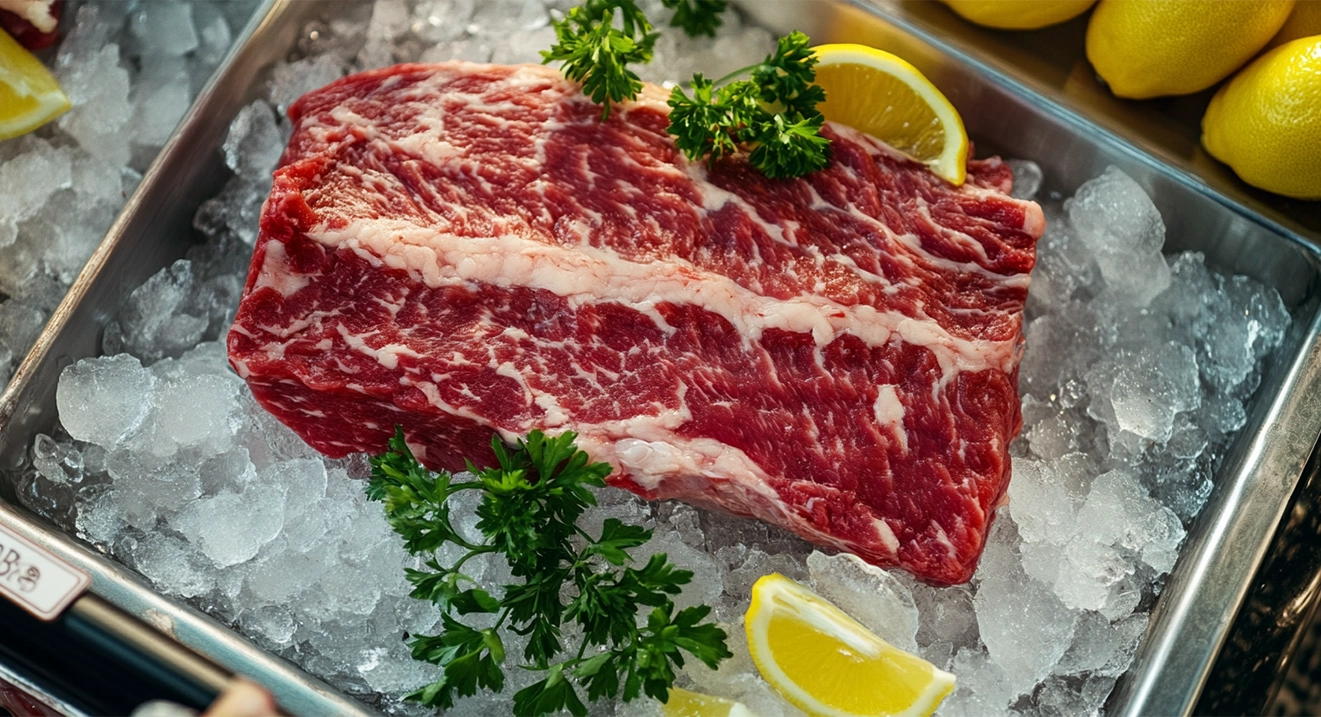
How to Select the Best Quality Brisket
When shopping for brisket, look for these key indicators to ensure you’re getting the best cut:
- Marbling: Check for even fat marbling throughout the meat. This is especially important for the point cut, as the fat helps with flavor and tenderness.
- Color: Fresh brisket should be a deep, bright red with minimal brown or grey spots. This indicates freshness.
- Thickness: Choose a brisket with a uniform thickness across the entire cut. This ensures even cooking, especially if you’re smoking or roasting it.
- Fat Cap: A good brisket, especially on the flat cut, should have a thick fat cap. This fat layer helps protect the meat during cooking and adds flavor.
- Source: Whenever possible, opt for grass-fed or pasture-raised brisket. These tend to have better flavor and a higher nutritional profile.
The Importance of Seasoning and Rubs
Seasoning and rubs are essential for enhancing the brisket’s flavor, allowing the meat’s natural richness to shine while adding depth and complexity. The right combination of spices and herbs can elevate your brisket to new heights, whether you’re smoking, roasting, or grilling. Here’s what you need to know:
Types of Seasoning: Salt, Pepper, and More
The most straightforward and classic brisket seasoning consists of salt and black pepper. These two ingredients are often all you need to bring out the best in your meat. However, you can experiment with other spices and herbs to customize your flavor profile. Some popular seasonings include:
- Salt is a critical ingredient. It helps draw out moisture from the meat, enhancing its flavor. Salt also helps tenderize the brisket by breaking down proteins.
- Black Pepper: The heat and sharpness of freshly ground black pepper add a subtle kick that complements the richness of the brisket.
- Garlic Powder adds an aromatic, savory layer of flavor that pairs wonderfully with the brisket’s natural umami.
- Onion Powder: Enhances the savory profile and adds depth.
- Paprika: A mild spice that can lend a touch of smokiness or sweetness, depending on the variety.
- Cayenne Pepper: Adds heat for those who enjoy a spicier flavor profile.
- Brown Sugar is used in rubs to balance the savory flavors with a hint of sweetness and caramelization when cooked.
The key is finding a balance between these flavors to suit your taste.
Homemade Rubs vs. Store-Bought Rubs
While store-bought rubs are convenient and often packed with bold flavors, making your rub can give you complete control over the ingredients and flavor intensity. Here are the pros and cons of both options:
- Homemade Rubs:
- Pros: It is customizable to your taste, allows you to control the quality of ingredients, and avoids additives or preservatives that may be present in store-bought options. You can adjust the ratios to suit the meat, whether you prefer a sweet, smoky, or spicy rub.
- Cons: Requires more time and effort to mix and experiment with different flavors.
- Store-Bought Rubs:
- Pros: It’s quick and easy to use, and a wide variety of pre-mixed flavors are available. It’s great for beginners or when you’re short on time.
- The cons are that it may contain artificial flavors, MSG, or preservatives, and you may have limited control over the flavor balance.
Both options can yield excellent results depending on your needs, but homemade rubs allow for a personal touch.
Applying the Rub: Techniques for Maximum Flavor
To get the most flavor from your rub, follow these steps:
- Prep the Meat: Begin by trimming the brisket to your desired fat level, ensuring it’s clean and dry. Pat the meat dry with paper towels to remove any excess moisture, as this helps the rub adhere better.
- Generously Coat: Apply the rub generously to all sides of the brisket. Don’t be afraid to use a fair amount—this helps form a flavorful crust during cooking. Press the rub into the meat to ensure it sticks well.
- Resting Time: Let the rubbed brisket rest for at least 30 minutes to 1 hour at room temperature before cooking. This allows the flavors to begin infusing into the meat. For deeper flavor, you can refrigerate the brisket overnight after applying the rub.
- Rub Techniques: You can apply the rub with your hands or a shaker to create a more even coat. For an additional layer of flavor, you can even use a marinade or inject the brisket with flavoring before applying the rub.
- Cooking: Whether smoking, roasting, or grilling, the rub will form a crust as the meat cooks, adding flavor and texture. For smoking, low and slow cooking is ideal for developing the full depth of flavor.
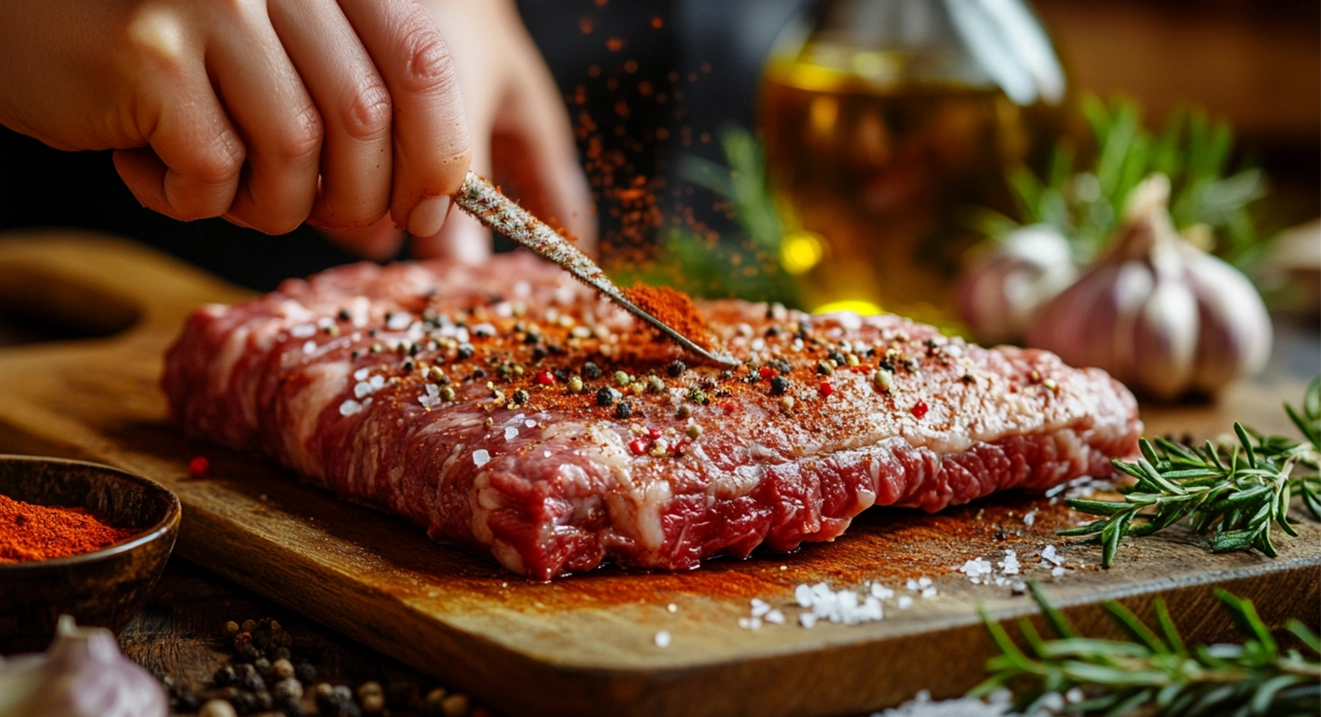
Preparing the Brisket for Smoking
Proper preparation is essential for achieving the best smoking results. Trimming and enhancing the brisket with marinades or injections will ensure your meat stays flavorful and tender throughout the long smoking process.
Trimming the Brisket for Optimal Cooking Results
- Fat Cap Management:
- Brisket has a thick fat cap that protects the meat as it cooks. Leave about 1/4 inch of the fat cap on the brisket for optimal smoking. This helps protect the meat during the long cooking process while allowing enough fat to render down, keeping the brisket moist. If the fat cap is too thick, it can prevent the rub from penetrating the meat, and it may not render as efficiently.
- Trim Excess Fat and Silver Skin:
- Look for any areas of excess fat or tough silver skin, a thin membrane of connective tissue on the underside of the brisket. Silver skin won’t break down during cooking and can result in a chewy texture. Use a sharp knife to trim away any visible silver skin and excess fat over 1/4 inch thick.
- Shape the Brisket:
- For even cooking, shape the brisket so it’s a uniform thickness. If the point cut is too thick, it can cause uneven cooking, so trim it down if necessary. The brisket will cook more evenly by maintaining a consistent shape, especially if you smoke at low temperatures for several hours.
- Trim the Brisket’s Ends:
- Sometimes, the ends of the brisket may be dry or overdone due to exposure to direct heat. Trimming the ends slightly ensures a more even cook.
By trimming the brisket properly, you ensure that the fat renders down correctly, the rub sticks, and the meat cooks evenly for the best texture and flavor.
How to Marinate or Inject Brisket for Added Flavor
In addition to applying a rub, marinating or injecting the brisket can elevate its flavor even further, providing moisture and richness throughout the meat. Here’s how to use both techniques:
- Marinating:
- Why Marinade? A marinade is a liquid mixture that helps infuse the meat with additional flavors while adding moisture. Marination benefits brisket, especially if you want to enhance its flavor profile.
- How to Marinate: To marinate brisket, prepare a marinade that typically includes olive oil, vinegar (or another acid like lemon juice), herbs, spices, and sometimes sugar for sweetness. Coat the brisket entirely with the marinade, then refrigerate it for at least 4–6 hours or, ideally, overnight. Occasionally, turn the meat to ensure it is evenly coated.
- Tip: Be cautious of the marinade’s acidity. If too much acid is used, it can begin to break down the meat too quickly, leading to a mushy texture.
- Injecting:
- Why Inject?: Injecting is an excellent way to ensure flavor and moisture are distributed evenly throughout the meat, especially for more significant cuts like brisket. The injection allows liquids and seasonings to penetrate deep into the muscle fibers.
- How to Inject: Use a meat injector to inject a mixture of broth, marinade, or even a simple saline solution (water, salt, and a bit of sugar) into the brisket at multiple points, focusing on the thickest parts, such as the point. Add flavoring agents like garlic, onion powder, or Worcestershire sauce into the injection mix.
- Tip: Be sure to inject evenly, distributing the solution across different areas of the meat. Please don’t overdo it, as too much liquid can produce a mushy texture or cause the brisket to become too salty.
Selecting the Right Wood for Smoking
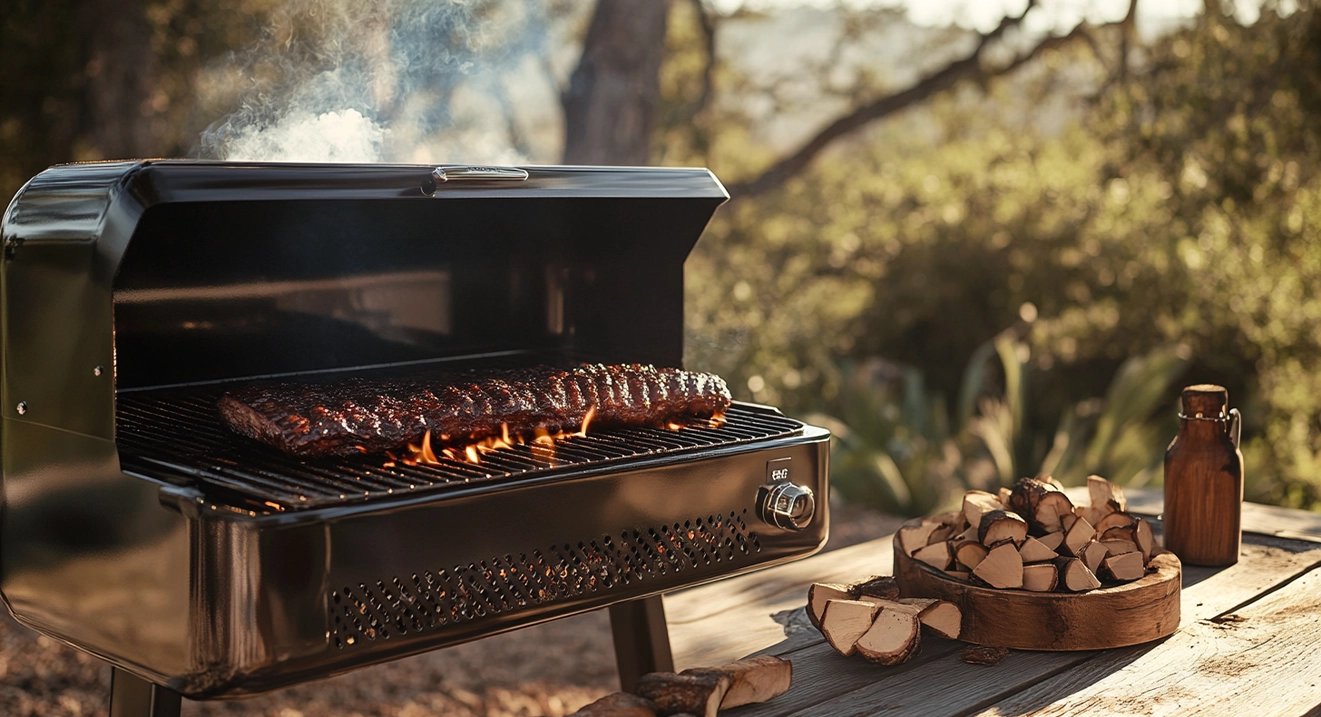
Choosing the right wood for smoking brisket is crucial, as the wood type directly impacts the flavor of the meat. Different woods impart unique flavors and aromas, enhancing the overall experience of your brisket. Here’s an overview of popular wood types and how they influence the flavor:
Popular Types of Wood to make a Smoked Brisket: Oak, Hickory, Mesquite
- Oak:
- Flavor Profile: Oak is a versatile, mild wood that produces a balanced, smoky flavor. It’s not too overpowering, which makes it an excellent choice for smoking brisket. It allows the meat’s natural flavor to shine while adding subtle smoky undertones.
- Best For: Oak is ideal for longer cooking, making it perfect for brisket. It provides a consistent, moderate smoke that pairs well with the meat’s rich flavor.
- Hickory:
- Flavor Profile: Hickory imparts an intense, robust smoke with a slightly sweet and nutty flavor. It’s one of the most popular woods for smoking meat and is primarily known for creating a deep, bold flavor.
- Best For Hickory is an excellent option for brisket if you want a stronger, more pronounced smoke flavor. However, be careful not to overuse it, as it can become overpowering and cause bitterness if smoked for too long.
- Mesquite:
- Flavor Profile: Mesquite is one of the most intense smoking woods, producing a strong, earthy, slightly spicy flavor. It’s very powerful and sometimes too bold for delicate cuts, but it works exceptionally well with rich meats like brisket.
- Best For Mesquite is best used for shorter smoking sessions or with milder woods. It’s ideal for those who enjoy a more aggressive, distinct, smoky flavor that can withstand the intensity of a well-cooked brisket.
How Wood Type Affects Flavor
The type of wood you use significantly impacts the flavor profile of your brisket:
- Milder Woods (Oak, Fruitwoods): These woods provide a balanced and subtle flavor that complements the brisket’s natural taste without overpowering it. They are excellent for long smoking sessions, allowing the meat to absorb a steady, gentle smoke.
- Stronger Woods (Hickory, Mesquite): These woods deliver a more pronounced, bolder smoke flavor, which can add complexity and depth to the brisket. However, because of their intensity, they should be used with care. Over-smoking with strong wood can result in bitterness or an overly smoky taste that masks the meat’s natural flavor.
- Combination of Woods: Many pitmasters blend different types of wood to achieve a balanced smoke profile. For instance, a mix of oak and cherry or Hickory and apple can offer the best of both worlds—an ideal blend of robust and subtle flavors.
Smoking Techniques and Temperature Control
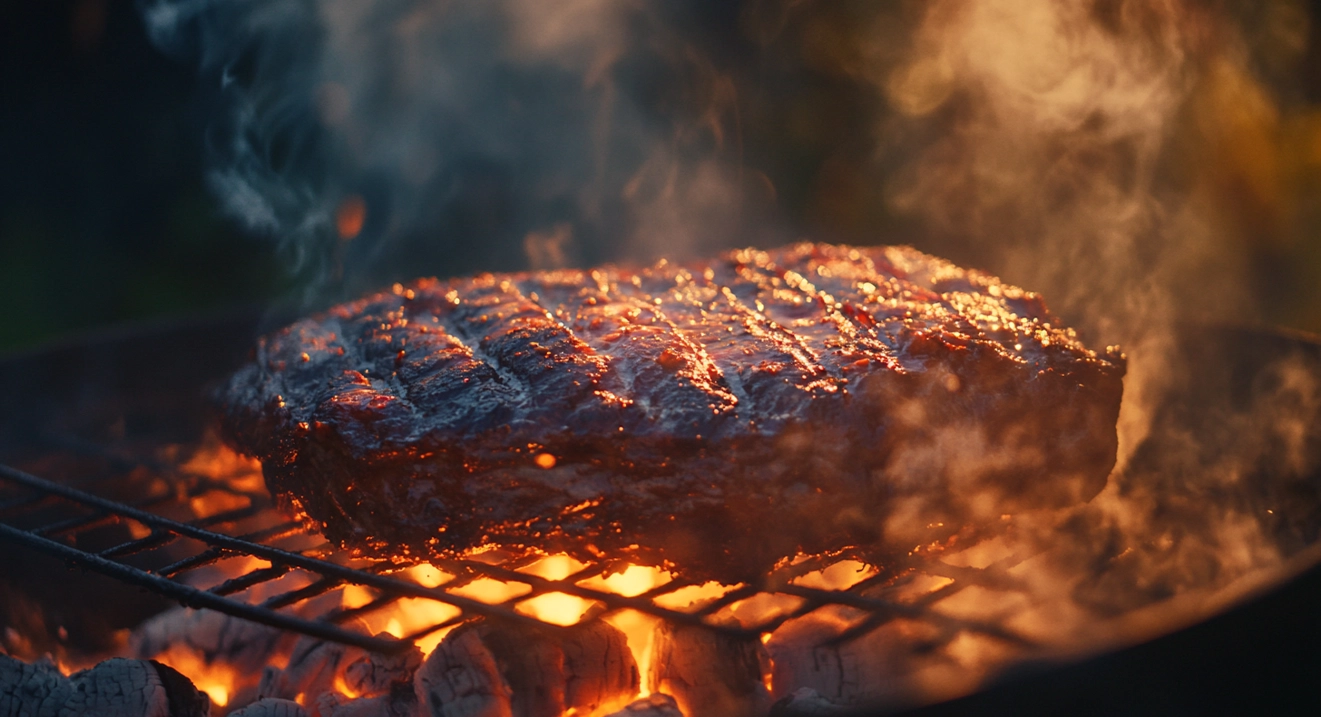
Smoked brisket is an art that requires patience, skill, and careful attention to detail. The key to achieving tender, flavorful brisket is understanding the proper smoking techniques and maintaining a consistent temperature. Here’s a breakdown of essential smoking techniques, temperature control, and smoker types:
Low and Slow Cooking: The Secret to Tender Smoked Brisket
The phrase “low and slow” is essential when smoking a brisket. Brisket is a tough, fatty cut of meat that requires extended cooking times at low temperatures to break down the connective tissue and fat, which results in a tender, juicy final product. Cooking at a low temperature (around 225°F to 250°F) for an extended period allows the collagen in the meat to turn into gelatin, making the brisket incredibly tender while maintaining moisture.
The long cooking time also allows the smoke to penetrate the meat slowly, adding layers of flavor. Brisket typically requires several hours of smoking—anywhere from 8 to 14 hours, depending on the size of the cut.
Understanding the Importance of Maintaining a Stable Temperature
It is crucial to maintain a consistent, stable temperature throughout the smoking process. If the smoker’s temperature fluctuates too much, the brisket could cook unevenly or dry out. Consistent heat helps ensure the meat cooks slowly and evenly, allowing the fat to render and the flavors to develop.
Here are a few tips to help maintain stable temperatures:
- Check smoker temperature regularly to ensure it’s within the desired range.
- Use a meat thermometer to monitor the internal temperature of the brisket.
- Avoid opening the smoker door too frequently, as this lets out heat and can cause temperature fluctuations.
The Role of the Smoker and Smoker Types: Offset, Pellet, and Electric Smokers
There are various types of smokers, each with its unique characteristics and benefits for smoking brisket:
Offset Smokers:
Offset smokers use indirect heat, with the heat source in a separate chamber from the cooking chamber. These smokers can provide a traditional smoky flavor but require more attention and skill to maintain a stable temperature. They are ideal for pitmasters who enjoy manually adjusting the fire and airflow.
Pellet Smokers:
Pellet smokers use compressed wood pellets as fuel, automatically fed into a firebox to maintain a consistent temperature. These smokers offer great convenience and are easier to control, making them a good choice for beginners and those who want more consistency with less hands-on effort.
Electric Smokers:
Electric smokers are easy to use and offer precise temperature control. They work by generating heat via electricity and using wood chips or chunks to add smoke. While they don’t provide the same level of traditional smoke flavor as offset or pellet smokers, they are perfect for those looking for a set-it-and-forget-it approach to smoking.
Frequently Asked Questions
What is the trick to tender a smoked brisket?
The key to smoking a tender brisket is low and slow cooking. This method allows the tough connective tissue in the meat to break down into gelatin, resulting in a tender, juicy texture. Maintaining a consistent smoking temperature of around 225°F to 250°F is crucial, ensuring the meat cooks slowly and evenly. Additionally, trimming the brisket properly, using the right wood for flavor, and wrapping the brisket in butcher paper or foil during the stall can all contribute to a tender result. Patience is also key—brisket requires time to cook properly.
What is the 3-2-1 rule for brisket?
The 3-2-1 rule is a smoking technique primarily used for ribs but can be adapted for brisket. It involves:
- The brisket was smoked uncovered for 3 hours at a low temperature (225°F to 250°F) to allow the smoke to infuse into the meat.
- 2 hours wrapped in foil or butcher paper at the same temperature. This helps to break through the stall and retain moisture.
- Unwrapped at a higher temperature (around 275°F) for one hour to allow the bark to form and give the brisket a nice, crispy exterior.
Some pitmasters modify this technique slightly for brisket, as the meat can require a longer smoking time due to its size. The core idea is to cook low and slow and then increase the temperature to finish with a nice crust.
What not to do when smoked brisket?
When smoking brisket, avoid these common mistakes:
- Take your time with the process: Smoking brisket takes time, sometimes up to 12-14 hours or more. Avoid trying to speed up the process by increasing the temperature too much.
- Don’t skip trimming: A thick fat cap or excess silver skin can prevent the rub from penetrating the meat and result in uneven cooking.
- Wait to open the smoker too often: You lose heat and smoke whenever you open the lid. Only open it when necessary (like checking the internal temperature or wrapping the brisket).
- Use only a little strong wood: Woods like Mesquite can be overpowering. Use them sparingly or mix them with milder woods like oak or fruitwood.
- Remember to rest the meat: After smoking, let the brisket rest for at least 30 minutes before slicing to allow the juices to redistribute.
What is the secret to a good smoked brisket?
The secret to a good smoked brisket lies in a combination of several factors:
- Low and slow cooking: This is the foundation for tender brisket. Patience allows the fat and connective tissue to break down, giving the meat a melt-in-your-mouth texture.
- Proper seasoning and rub: A balanced rub with salt, pepper, and other seasonings enhances the flavor without overpowering the meat’s natural taste.
- Wood choice: The right wood can elevate the brisket’s flavor. Milder woods like oak or fruitwood provide a balanced smoke without overpowering the meat.
- Stable temperature control: Consistent temperature control throughout the smoking process ensures even cooking and prevents drying.
- Resting the smoked brisket: Allowing the brisket to rest before slicing helps redistribute the juices, resulting in a moist, flavorful result.
